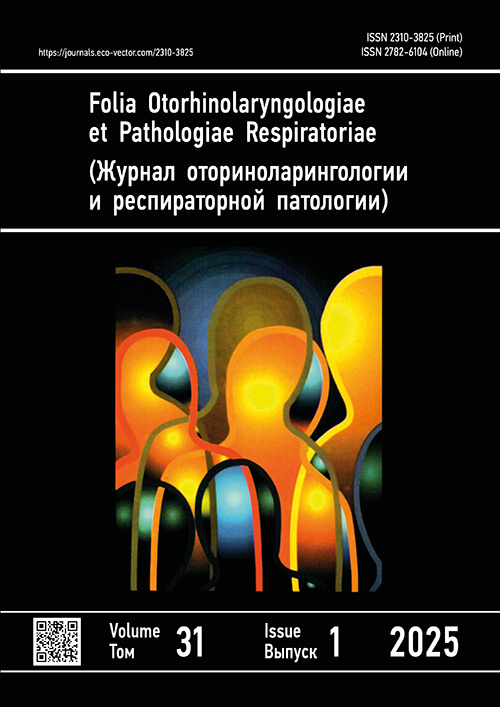Влияние длительного использования топических деконгестантов на мукоцилиарный клиренс
- Авторы: Покровская Е.М.1,2, Красножен В.Н.1,2, Золотенин М.К.2, Батыршин Т.Р.1
-
Учреждения:
- Российская медицинская академия непрерывного профессионального образования
- Казанский (Приволжский) федеральный университет
- Выпуск: Том 31, № 1 (2025)
- Страницы: 29-33
- Раздел: Научные исследования
- Статья получена: 12.03.2025
- URL: https://journals.eco-vector.com/2310-3825/article/view/677100
- DOI: https://doi.org/10.17816/fopr677100
- EDN: https://elibrary.ru/SCSESK
- ID: 677100
Цитировать
Полный текст
Аннотация
Обоснование. Распространенность медикаментозных ринитов в популяции составляет от 1 до 7%. Длительное применение топических деконгестантов при ринологической патологии угнетающе действует на мукоцилиарный транспорт, что делает их небезопасными.
Цель — определение влияния длительного использования топических деконгестантов на мукоцилиарную активность слизистой оболочки полости носа.
Методы. В исследование включены 80 пациентов в возрасте от 18 до 45 лет с диагнозом «медикаментозный ринит». Все пациенты были разделены на 4 группы: 1-я группа (группа контроля) — здоровые, 2-я группа — пациенты, использующие топические деконгестанты до 1 года, 3-я группа — использующие деконгестанты от 1 года до 10 лет и 4-я группа — использующие топические деконгестанты свыше 10 лет. Частоту биения ресничек исследовали с помощью методики высокоскоростной цифровой видеомикроскопии. Видеозапись 8–10 участков с сохранным биением ресничек выполняли с помощью высокоскоростной видеокамеры (Huateng Vision HT-SUA133GC-T) с максимальным разрешением изображения (1280×1024 пикселей) и максимальной частотой кадров (245 кадров в секунду), установленной вместо одного из окуляров микроскопа. Средняя частота кадров видеозаписи составляла 132±71,1 кадра в секунду. Полученные видеозаписи преобразовывали в последовательность кадров с помощью программы Free video to JPG converter, и далее последовательность кадров использовалась приложением CiliarMove для подсчета частоты биения ресничек.
Результаты. Проведенные исследования не выявили статистически значимых различий частоты биения ресничек слизистой оболочки нижних носовых раковин при использовании топических деконгестантов длительностью до 1 года и здоровых пациентов, тогда как у пациентов, использующих топические деконгестанты больше года, частота биения ресничек слизистой оболочки нижних носовых раковин была статистически значимо ниже, чем у здоровых исследуемых.
Заключение. Выявлена корреляционная связь между длительностью использования топических деконгестантов и мукоцилиарной активностью.
Ключевые слова
Полный текст
Об авторах
Елена Михайловна Покровская
Российская медицинская академия непрерывного профессионального образования; Казанский (Приволжский) федеральный университет
Автор, ответственный за переписку.
Email: epokrunia@inbox.ru
ORCID iD: 0000-0001-9437-4895
SPIN-код: 5051-9591
д-р мед. наук, доцент
Россия, Казань; КазаньВладимир Николаевич Красножен
Российская медицинская академия непрерывного профессионального образования; Казанский (Приволжский) федеральный университет
Email: vn_krasnozhon@mail.ru
ORCID iD: 0000-0002-1564-7726
SPIN-код: 4020-8920
д-р мед. наук, профессор
Россия, Казань; КазаньМаксим Константинович Золотенин
Казанский (Приволжский) федеральный университет
Email: mzolotenin@gmail.com
ORCID iD: 0009-0000-8303-3016
MD
Россия, КазаньТимур Рунарович Батыршин
Российская медицинская академия непрерывного профессионального образования
Email: taha1429@yandex.ru
ORCID iD: 0000-0001-8449-9504
канд. мед. наук, доцент
Россия, КазаньСписок литературы
- Fox N. The chronic effect of epinephrine and ephedrine on the nasal mucosa. Arch Otolaryngol. 1931;13(1):73–76. doi: 10.1001/archotol.1931.03660010083008
- Feinberg SM, Friedlaender S. Nasal congestion from frequent use of privine hydrochloride. J Am Med Assoc. 1945;128(15):1095–1096. doi: 10.1001/jama.1945.92860320001011
- Gray J. The mechanism of ciliary movement: VI. Photographic and stroboscopic analysis of ciliary movement. Proc R Soc Biol Sci Ser B. 1930;107:313–332. doi: 10.1098/rspb.1930.0075
- Proetz A. Essays on the applied physiology of the nose. St. Louis: Annals Publishing Co; 1953. 452 p.
- Canciani M, Barlocco EG, Mastella G, et al. The saccharin method for testing mucociliary function in patients suspected of having primary ciliary dyskinesia. Pediatr Pulmonol. 1988;5(4):210–214. doi: 10.1002/ppul.1950050406
- Miroshnichenko NA, Nikolaeva YuO, Savranskaya KV, Ryzhkova NS. Maintaining normal indicators of mucociliary transport is the basis for the adequate and correct use of local antiseptics. Effektivnaya Farmakoterapiya. 2024;16(20):10–13. (In Russ.) doi: 10.33978/2307-3586-2024-20-16-10-13 EDN: NRKDBM
- Dalhamm T. Mucous flow and ciliary activity in the trachea of rats and rats exposed to respiratory irritant gases. Acta Physiol Scand. 1967;36(123):432.
- Yager J, Chen T, Dulfano MJ. Measurement of frequency of ciliary beats of human respiratory epithelium. Chest. 1978;73(5):627-633. doi: 10.1378/chest.73.5.627
- Mareev OV, Mareev GO, Ermakov YuYu, Fedosov IV. Study of local mucociliary clearance in the middle nasal meatus in clinically healthy individuals and patients with foreign bodies in the maxillary sinus. Science and Innovations in Medicine. 2022;7(2):128–133. doi: 10.35693/2500-1388-2022-7-2-128-133 EDN: NOKKCG
- Chilvers MA, Rutman A, O’Callaghan C. Functional analysis of cilia and ciliated epithelial ultrastructure in healthy children and young adults. Thorax. 2003;58(4):333–338. doi: 10.1136/thorax.58.4.333
- Svistushkin VM. Inflammatory diseases of the upper respiratory tract in elderly patients: features of development and drug treatment. Consilium Medicum. 2003;5(12):686–690. EDN: UENWFL
- Mwimbi XK, Muimo R, Green MW, Mehta A. Making human nasal cilia beat in the cold: a real time assay for cell signalling II. Cell Signal. 2003;15(4):395–402. doi: 10.1016/S0898-6568(02)00143-2
- Smith CM, Hirst RA, Bankart MJ, et al. Cooling of cilia allows functional analysis of the beat pattern for diagnostic testing II. Chest. 2011;140(1):186–190. doi: 10.1378/chest.10-1920
- Cohen NA. Sinonasal mucociliary clearance in health and disease. Ann Otol Rhinol Laryngol Suppl. 2006;196:20–26. doi: 10.1177/00034894061150s904
- Shaari J, Palmer JN, Chiu AG, et al. Regional analysis of sinonasal ciliary beat frequency. Am J Rhinol. 2006;20(2):150–154. doi: 10.1177/194589240602000205
- Shilenkova VV. Frequency of cilia beating of the nasal translucent epithelium of the nasal cavity in healthy children. Russian Otorhinolaryngology. 2008;(2):87-89. (In Russ.) EDN: IULMHB
- Kramnoy AI, Kozlov BN. Effect of nasal decongestants on locomotor activity of the ciliary apparatus of nasal mucosa in patients with acute purulent rhinosinusitis. Russian Bulletin of Otorhinolaryngology. 2010;(1):67–68. EDN: OYENUJ
- Vasina LA. Effect of topical vasoconstrictor drugs on nasal mucociliary transport [dissertation]. Moscow: Russian Medical Academy of Postgraduate Education; 2010. 119 p. Available from: https://www.dissercat.com/content/vliyanie-mestnykh-sosudosuzhivayushchikh-preparatov-na-mukotsiliarnyi-transport-polosti-nosa (In Russ.)
Дополнительные файлы









